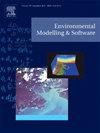利用GOES-16数据和U-net卷积神经网络建模方法推进imerger的及时卫星降水
IF 4.8
2区 环境科学与生态学
Q1 COMPUTER SCIENCE, INTERDISCIPLINARY APPLICATIONS
引用次数: 0
摘要
及时的降水信息对水资源管理和灾害监测至关重要。在地面测量有限的地区,卫星降水产品(SPPs)提供了一个有价值的替代方案,尽管数据延迟通常会造成实时应用的信息差距。本研究使用基于u - net的卷积神经网络(CNN)模型解决了imerger的延迟差距,该模型使用近瞬时GOES-16卫星数据进行训练。确定了GOES-16红外波段(6.2、6.9、7.3、8.4和11.2 μm)的最佳组合,以增强imerger预测。CNN模型的性能,通过定量和定性指标进行评估,显示RMSE为0.46 mm/h, Pearson相关系数为0.60,关键成功指数为0.53。该模型在预测低强度降水(< 3mm /h)方面表现良好,但由于数据不平衡,在预测高强度降水时面临挑战。这些发现促进了spp和深度学习在业务水文学中的应用。本文章由计算机程序翻译,如有差异,请以英文原文为准。

Advancing timely satellite precipitation for IMERG-ER using GOES-16 data and a U-net convolutional neural network modelling approach
Timely precipitation information is essential for water resources management and hazard monitoring. In regions with limited ground-based measurements, satellite precipitation products (SPPs) provide a valuable alternative, though data latency often creates an information gap for real-time applications. This study addresses the latency gap of IMERG-ER using a U-Net-based Convolutional Neural Network (CNN) model, trained with near-instantaneous GOES-16 satellite data. The optimal combination of GOES-16 infrared bands (6.2, 6.9, 7.3, 8.4, and 11.2 μm) was determined to enhance IMERG-ER predictions. The CNN model's performance, evaluated with both quantitative and qualitative metrics, showed an RMSE of 0.46 mm/h, a Pearson's correlation coefficient of 0.60, and a Critical Success Index of 0.53. The model performed well in predicting low-intensity precipitation (<3 mm/h), which occurs 97 % of the time, but faced challenges with high-intensity events due to data imbalance. These findings advance the use of SPPs and deep learning for operational hydrology.
求助全文
通过发布文献求助,成功后即可免费获取论文全文。
去求助
来源期刊

Environmental Modelling & Software
工程技术-工程:环境
CiteScore
9.30
自引率
8.20%
发文量
241
审稿时长
60 days
期刊介绍:
Environmental Modelling & Software publishes contributions, in the form of research articles, reviews and short communications, on recent advances in environmental modelling and/or software. The aim is to improve our capacity to represent, understand, predict or manage the behaviour of environmental systems at all practical scales, and to communicate those improvements to a wide scientific and professional audience.
 求助内容:
求助内容: 应助结果提醒方式:
应助结果提醒方式:


